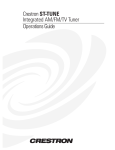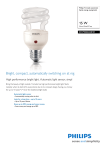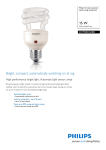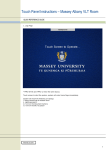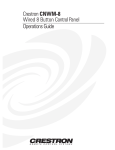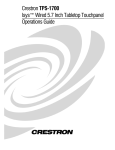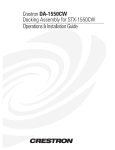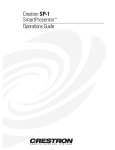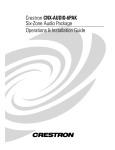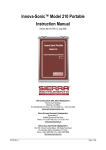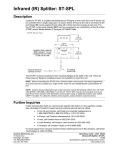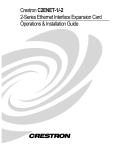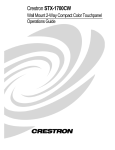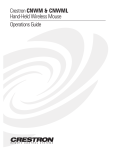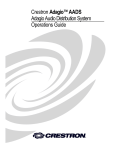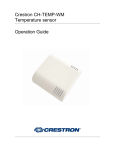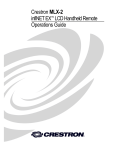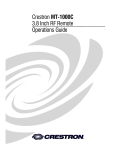Download Crestron electronic AM/FM/TV Tuner User's Manual
Transcript
This document was prepared and written by the Technical Documentation department at: Crestron Electronics, Inc. 15 Volvo Drive Rockleigh, NJ 07647 1-888-CRESTRON Crestron ST-TUNE Integrated AM/FM/TV Tuner Contents Integrated AM/FM/TV Tuner: ST-TUNE Description Functional Description Physical Description Leading Specifications Setup Network Wiring Preparation for Use Identity Code Firmware Upgrade Programming with SIMPL Windows Configure ST-TUNE Program ST-TUNE and STI-TUNE Symbols Basic Example Program Advanced Example Program Problem Solving Troubleshooting Further Inquiries Future Updates Future Firmware Upgrades Appendix 1: High-Gain AM Antenna Materials Required Fabrication Instructions Appendix 2: STI-TUNE TV Receptions Appendix 3: Upgrade Firmware Version Prior to 2.17 Return and Warranty Policies Merchandise Returns / Repair Service CRESTRON Limited Warranty Operations Guide - DOC. 5833A 1 1 1 2 6 8 8 9 10 11 14 15 15 20 21 22 22 24 24 24 25 25 25 27 28 35 35 35 Contents • i Crestron ST-TUNE Integrated AM/FM/TV Tuner Integrated AM/FM/TV Tuner: ST-TUNE Description Functional Description The ST-TUNE is a Crestron remote control network (herein referred to as the Cresnet system) optimized high-performance AM/FM/WX (Weather radio) and television (TV) tuner. The ST-TUNE provides professional audio that connects directly to and is accessed by a Cresnet system. The Cresnet system can store virtually unlimited radio station and TV channel presets. The presets are available for recall through Cresnet keypads, remote control devices, and/or touchpanels. The frequency of the radio station or TV channel being received is displayed on the ST-TUNE and can also be displayed on a touchpanel. The ST-TUNE is also available as an international version with the unit nomenclature of STI-TUNE. All of the features are identical with the exceptions of TV reception formats and FM and TV input connectors. The ST-TUNE receives National Television System Committee (NTSC) M/N format video and the STI- Operations Guide - DOC. 5833A Integrated AM/FM/TV Tuner: ST-TUNE • 1 Integrated AM/FM/TV Tuner Crestron ST-TUNE Physical Description The ST-TUNE, shown below, is housed in a black enclosure with silk-screened labels on the front and rear panels. On the front panel are 12 light-emitting diodes (LEDs) for indicating the status of the unit, the digital display for showing the band, radio station or TV channel being received, two control buttons, and three function selection buttons. All connections are made on the rear panel ports. There are four rubber feet on the base of the unit for stability and to prevent slippage. ST-TUNE Physical Views 2 • Integrated AM/FM/TV Tuner: ST-TUNE Operations Guide - DOC. 5833A Crestron ST-TUNE Integrated AM/FM/TV Tuner ST-TUNE Ports Each ST-TUNE rear panel port has a silk-screened label. For the descriptions of the ports, refer to the following diagrams and sections. ST-TUNE Rear Panel 12VDC 1A NET NET AUDIO L VIDEO AM FM TV R CRESTRON ELECTRONICS INC. ROCKLEIGH, N.J. 07647 USA STI-TUNE (International Version) Rear Panel 12VDC 1A NET NET AUDIO L VIDEO AM FM TV R CRESTRON ELECTRONICS INC. ROCKLEIGH, N.J. 07647 USA 12 VDC 1A This direct current (DC) power socket connector is used to supply power via the Operations Guide - DOC. 5833A Integrated AM/FM/TV Tuner: ST-TUNE • 3 Integrated AM/FM/TV Tuner Crestron ST-TUNE AUDIO (L + R) This pair of RCA jacks output the left (white center insulator) and right (red center insulator) channel line-level audio to an audio processor such as the CNX-PAD8. The audio can also be connected to the audio inputs of a TV monitor, audio switcher and/or audio distribution equipment. VIDEO This RCA jack outputs composite TV video from the ST-TUNE. The center insulator of this jack is yellow and may be connected to any video device that accepts a composite input. AM This RCA jack is used to input AM radio signals via the supplied AM antenna. The center insulator of this jack is white. Using a commercially available RCA extender cable (not supplied but RadioShack® part numbers 42-2352 and 274-874 recommended), the antenna can be mounted outside of a “noisy” equipment rack. For fabrication instructions of a high-gain AM antenna for use in areas of high ambience interference or weak reception, refer to Appendix 1 that begins on page 25. FM This connector is used to input FM radio signals. The ST-TUNE uses a 75-ohm “F” Type coaxial connector and the international STI-TUNE uses a 9.5 millimeter (mm) “IEC” Type connector. The signals may be from cable input (if FM signal is available), digital satellite receiver, FM antenna, weather station, etc. TV This connector is used to input TV channel audio and video signals. The ST-TUNE uses a 75-ohm “F” Type coaxial connector and the STI-TUNE uses a 11-mm “IEC” Type connector. The signals may be cable input, digital satellite receiver, TV antenna, etc. ST-TUNE Front Panel Indicators and Buttons There are 12 LED indicators, one digital display, two control buttons, and three function selection buttons located on the front panel of the ST-TUNE. For the descriptions, refer to the diagram below and the following paragraphs. ST-TUNE Front Panel AM AM/FM-TV TUNER SIG PWR FM WX TV PRE BAND NET MONO TUNE SAP SRCH CRESTRON MONO MODE ST - T U N E PWR This LED (green) illuminates when operating power is supplied to the ST-TUNE. Operating power is supplied by the external power pack (included) or the network wiring via the rear panel connectors. 4 • Integrated AM/FM/TV Tuner: ST-TUNE Operations Guide - DOC. 5833A Crestron ST-TUNE Integrated AM/FM/TV Tuner NET This LED (yellow) indicates that the SIMPL program currently loaded in the control system has a network device defined at the same NET ID code as the ST-TUNE. The LED flashes when communication with the Cresnet system and the ST-TUNE is occurring. BAND INDICATORS AND DIGITAL DISPLAY The AM, FM, WX (Weather Radio), or TV indicators contain four LEDs (red) to display the active band of the ST-TUNE. The digital display shows the radio frequency or TV channel being received. RECEPTION INDICATORS These three LEDs (red) indicate the reception status of the ST-TUNE. The LED labeled SIG indicates the strength of the incoming FM signal, the steadier and brighter the LED the stronger the signal. The MONO indicator illuminates when the mono selector is activated while in the FM, WX or TV band and the SAP indicator illuminates when the SAP selector is activated while in the TV band (regardless of whether or not SAP information is being received). NOTE: The SIG LED provides the most accurate indication of the incoming FM signal after the ST-TUNE has reached optimum operating temperature (approximately 10 minutes). TUNING MODE INDICATORS These three LEDs (red) indicate the tuning mode of the ST-TUNE. The LED labeled PRE indicates that the preset mode (the preset functions are determined by the control system program) is activated. The TUNE indicator illuminates when the manual tuning mode is activated and SRCH indicates that search tuning is activated. UP/DOWN CONTROL BUTTONS During the PRE mode, the up or down control buttons cause the Cresnet control system to perform a preset or pre-programmed function. If not programmed, these buttons have no function during this mode. Refer to “Programming with SIMPL Windows” on page 13 for further information. While in the TUNE mode, the up or down buttons increment and decrement the radio or TV frequency by one step during each press. If pressed and held, the ST-TUNE will rapidly tune up or down. If the selected band supports the search tuning function, pressing either button during the SRCH mode searches the radio or TV frequency range for the next strong incoming signal. NOTE: The SRCH mode performs most accurately after the ST-TUNE has reached optimum operating temperature (approximately 10 minutes) and is receiving an adequately strong signals. Refer to the Sense-High and Sense-Low entry of the “ST-TUNE and STI-TUNE Symbol Input Descriptions” table on page 18 for further information. SELECTION BUTTONS The selection buttons cycle the reception functions of the ST-TUNE. Repeatedly pressing the BAND button cycles through the AM, FM, WX, and TV bands. Pressing the MONO button toggles between the mono and stereo reception (for all modes except AM in ST-TUNE, for all modes except AM and TV in international version STI-TUNE) and the MODE button cycles through the preset, manual, or search tuning modes. Operations Guide - DOC. 5833A Integrated AM/FM/TV Tuner: ST-TUNE • 5 Integrated AM/FM/TV Tuner Crestron ST-TUNE Leading Specifications The five tables in this section provide summaries of the specifications for the ST-TUNE. Dimensions and weight are rounded to the nearest hundredth unit. Leading Specifications of the ST-TUNE DETAILS 12VDC, external power pack or 9 Watts (24VDC @ 0.375A), network 3E 1 Version 1.51 or later with library update file 115 later 6 • Integrated AM/FM/TV Tuner: ST-TUNE Operations Guide - DOC. 5833A Crestron ST-TUNE Integrated AM/FM/TV Tuner FM Tuner Specifications DETAILS Input Connector: US "F" Type Coaxial, female, 75 ohms International "IEC" Type Coaxial, 9.5mm male 87.5MHz to 107.9MHz Frequency Range 11 (dBf) Usable Sensitivity, Mono 74dB / 70dB S/N Ratio @ 65 dBf, mono / stereo 0.05% THD @ 1KHz mono/stereo Sensitivity, Adjacent / Alternate Channel 5dB / 65dB 100dB AM Rejection 55dB Stereo Separation 45dB 1VRMS Audio Output Level, Line @ 10k ohms Operations Guide - DOC. 5833A Integrated AM/FM/TV Tuner: ST-TUNE • 7 Integrated AM/FM/TV Tuner Crestron ST-TUNE NOTE: Equipment has been tested and found to comply with the limits for a Class B digital device, pursuant to part 15 of the FCC Rules. These limits are designed to provide reasonable protection against harmful interference in a residential installation. The equipment generates, uses and can radiate radio frequency energy and, if not installed and used in accordance with the instructions, may cause harmful interference to radio communications. However, there is no guarantee that interference will not occur in a particular installation. If this equipment does cause harmful interference to radio or television reception, which can be determined by turning the equipment off and on, the user is encouraged to try to correct the interference by one or more of the following measures: n Reorient or relocate the receiving antenna. n Increase the separation between the equipment and receiver. n Connect the equipment into an outlet on a circuit different from that to which the receiver is connected. n Consult the dealer or an experienced radio/TV technician for help. As of the date of manufacture, this unit has been tested and found to comply with specifications for CE marking. Setup Network Wiring CAUTION: Crestron modular cables are rated for a maximum of two (2) amperes. Do not exceed this current capacity for any modular device. If more current is required, connect an appropriate external power pack to the device. NOTE: If making category 5 connections to the Cresnet peripherals, refer to the latest revision of the Cresnet Mini Network CAT 5 Interconnect Drawing (Doc. 5819). This document can be obtained from the Products page (PRODUCT MANUALS, Software and Wiring Diagrams section) or Downloads page (CABLES and MANUAL Libraries, search for CAT5.PDF) of Crestron’s website (www.crestron.com). New users are required to register to obtain access to the FTP site. NOTE: Review the latest revision of the Network Modular Cable Requirements (Doc. 5682). This document can be obtained from the Products page (PRODUCT MANUALS, Software and Wiring Diagrams section) or Downloads page (CABLES and MANUAL Libraries, search for MODULAR.PDF) of Crestron’s website (www.crestron.com). NOTE: The CNHBLOCK should be used when wiring multiple Cresnet devices to a system. Use only Crestron modular cables when making connections to the CNHBLOCK modular ports. DO NOT use standard, modular 6-conductor telephone cables. Most telephone cables are wired in a crisscross fashion and are not compatible with Crestron equipment. 8 • Integrated AM/FM/TV Tuner: ST-TUNE Operations Guide - DOC. 5833A Crestron ST-TUNE Integrated AM/FM/TV Tuner When calculating the wire gauge for a particular Cresnet run, the length of the run and the load factor of each network unit to be connected must be taken into consideration. If Cresnet units are to be daisy-chained on the run, the load factor of each unit to be daisy-chained must be added together to determine the load factor of the entire chain. If the unit is a home-run from a Crestron system power supply network port, the load factor of that unit is the load factor of the entire run. The length of the run in feet and the load factor of the run should be used in the following resistance equation to calculate the value on the right side of the equation. Resistance Equation R < 40,000 L x LF Where: R = Resistance (refer to next table). L = Length of run (or chain) in feet. LF = Load factor of entire run (or chain). The required wire gauge should be chosen such that the resistance value is less than the value calculated in the resistance equation. Refer to the table below. Wire Gauge Values RESISTANCE (R) WIRE GAUGE 4 6 10 15 13 16 18 20 22 24 (Double-CAT 5) NOTE: All Cresnet wiring must consist of two twisted-pairs. One twisted pair is the +24V conductor and the GND conductor and the other twisted pair is the Y conductor and the Z conductor. NOTE: When daisy-chaining Cresnet units, always twist the ends of the incoming wire and outgoing wire which share a pin on the network connector. After twisting the ends, tin the twisted connection with solder. Apply solder only to the ends of the twisted wires. Avoid tinning too far up the wires or the end becomes brittle. After tinning the twisted ends, insert the tinned connection into the Cresnet connector and tighten the retaining screw. Repeat the procedure for the other three conductors. Preparation for Use Refer to the hookup diagram on the next page which shows ST-TUNE connections. Other than making the power connection last, complete the connections in any order. NOTE: Refer to the latest revision of the Crestron Network Modular Cable Requirements (Doc. 5682) when making connections to the ports labeled NET. This document can be obtained from the Products page (PRODUCT MANUALS, Software and Wiring Diagrams section) or Downloads page (CABLES and MANUAL Libraries, search for MODULAR.PDF) of Crestron’s website (www.crestron.com). New users are required to register to obtain access to the FTP site. NOTE: The external power pack and AM antenna are supplied with the ST-TUNE. All other modular cables, patch cords, or coaxial cables are not provided. Operations Guide - DOC. 5833A Integrated AM/FM/TV Tuner: ST-TUNE • 9 Integrated AM/FM/TV Tuner Crestron ST-TUNE NOTE: The location of the ST-TUNE is an important factor in the AM radio reception. The reception is also dependent on its placement and the construction of the building, locate the unit outside of any metal enclosures to achieve the best performance. A commercially available RCA extender cable (not supplied but RadioShack® part numbers 42-2352 and 274-874 are recommended), may be used to mount the antenna outside of a “shielded area or a “noisy” equipment rack. NOTE: For fabrication instructions of a high-gain AM antenna for use in areas of high ambience interference or weak reception areas, refer to Appendix 1 that begins on page 25. NOTE: The diagram below shows the US version ST-TUNE that requires “F” type, 75 ohm coaxial connectors for the FM and TV inputs. The international version STI-TUNE requires “IEC” connectors, 9.5mm for FM and 11mm for TV. Hookup Diagram for ST-TUNE NET NET AUDIO L 10 • Integrated AM/FM/TV Tuner: ST-TUNE VIDEO AM FM TV R Operations Guide - DOC. 5833A Crestron ST-TUNE Integrated AM/FM/TV Tuner 1. Attach one of the ST-TUNEs to the control system (verify that the software is running). 2. From the SIMPL Windows or VT Pro-e menu, select Tools | Viewport to open the Crestron Viewport. 3. From the Viewport menu, select Functions | Set Network ID. The software checks the baud rate and then opens the “Set Network ID” dialog box. 4. In the “Set Network ID” dialog box, select the ST-TUNE from the Current Network Devices text window. 5. From the Choose the new network ID for the selected device (Hex): text box, select the new Net ID for the ST-TUNE. 6. Click Set ID to initiate the change. This will display the “ID command has been sent” dialog box. 7. In the “Command Complete” dialog box, click OK. 8. In the Current Network Devices text window, verify the NET ID code. 9. In the “Set Network ID” dialog box, click Close. NOTE: The new NET ID code may also be verified by selecting Diagnostics | Report Network Devices in the Viewport (alternatively, depress F4). 10. Repeat this procedure for each ST-TUNE to be added to the Cresnet system. Firmware Upgrade To upgrade the firmware of a ST-TUNE, a local PC that contains the Crestron Viewport (available in SIMPL Windows or VT Pro-e) is required. To connect the PC to the control system, refer to the “Obtaining Communications” section of the Operators Guide supplied with the appropriate control system. The latest version of the Operations Guides can be obtained from the Products page (PRODUCT MANUALS, Hardware section) or Downloads page (MANUAL Library) of Crestron’s website (www.crestron.com). New users are required to register in order to obtain access to the FTP site. Firmware upgrade files are obtained from the What’s New page (Other Products section) or the Downloads page (UPGRADES Library, search for RADIOFIX.EXE) of Crestron’s website. To upgrade ST-TUNE firmware, complete the following steps. 1. Make sure that no programs accessing the COM port of the PC. 2. At the PC, start SIMPL Windows or VT Pro-e. 3. From the SIMPL Windows or VT Pro-e menu bar, select Tools | Viewport to open the Crestron Viewport. NOTE: SIMPL Windows may open with an opening splash screen and may display the “What do you want to do?” dialog box. If so, close the dialog box and continue. 4. Operations Guide - DOC. 5833A Refer to diagram on the next page. From the Viewport menu, select Setup | Communications settings (alternatively, depress Alt+D) to open the Port Settings dialog box. Integrated AM/FM/TV Tuner: ST-TUNE • 11 Integrated AM/FM/TV Tuner Crestron ST-TUNE Accessing the Port Settings Dialog Box 5. Refer to the dialog box shown below and verify the communications settings. Make sure that parity is set to None, data bits to Eight, and XModem is selected. NOTE: If performing a firmware upgrade via Ethernet, select TCP/IP as the connection type and provide the IP address. Port Settings Dialog Box 12 • Integrated AM/FM/TV Tuner: ST-TUNE Operations Guide - DOC. 5833A Crestron ST-TUNE Integrated AM/FM/TV Tuner 6. Refer to diagram below. From the Viewport menu, select Diagnostics | Report Network Devices (alternatively, depress F4). Accessing the Network Devices 7. In the Viewport return display, observe the firmware version of the ST-TUNE. 8. Perform the appropriate step. 8a. If the firmware version is version 2.17 or later, continue with this procedure. 8b. If the firmware version is prior to version 2.17, proceed to step 8 of “Appendix 3” that begins on page 28. 9. As shown below, select File Transfer | Load Network Device from the Viewport menu. Select Load Network Device Operations Guide - DOC. 5833A Integrated AM/FM/TV Tuner: ST-TUNE • 13 Integrated AM/FM/TV Tuner Crestron ST-TUNE 10. Refer to the diagram below. Select the NET ID of the ST-TUNE and then click OK. “Select Network ID” Dialog Box 11. As shown below, browse to the firmware directory, select the downloaded firmware (UPG) file and click Open. The transfer will complete automatically. Select Firmware (UPG) File NOTE: When the external power pack is disconnected from the ST-TUNE, operating power will automatically switch to Cresnet power supplied via the NET connector(s). To remove power from the unit, make sure both external power pack and NET connector(s) are removed. 12. Remove operating power from the ST-TUNE, wait several seconds and reconnect power. 13. Close the Viewport, exit SIMPL Windows or VT Pro-e, and disconnect the programming cable from the PC and the control system. Programming with SIMPL Windows SIMPL (Symbol Intensive Master Programming Language) is an easy-to-use programming language that is completely integrated and compatible with all Crestron system hardware. The objects that are used in SIMPL are called symbols. SIMPL Windows offers drag and drop functionality in a familiar Windows® environment. SIMPL Windows is Crestron's software for programming Crestron control systems. It provides a well-designed graphical environment with a number of workspaces (i.e., windows) in which a programmer can select, configure, program, test, and monitor a Crestron control system. 14 • Integrated AM/FM/TV Tuner: ST-TUNE Operations Guide - DOC. 5833A Crestron ST-TUNE Integrated AM/FM/TV Tuner The next four sections describe a ST-TUNE within a SIMPL Windows program. The first section provides initial configuration information, the second section details the SIMPL symbol, the third section describes how a basic example program works by using a textual description and a block diagram, and the fourth section describes the screens of an advanced example program. NOTE: The following descriptions assume that the reader has knowledge of SIMPL Windows. If not, refer to the extensive help information provided with the software. NOTE: VT Pro-e (version 2.1.8 or later) is required for the ST-TUNE example touchpanels. The latest software version can be obtained from the What’s New page (VisionTools Pro-e section) or Downloads page (VTPRO-E Library) of Crestron’s website (www.crestron.com). New users are required to register in order to obtain access to the FTP site. NOTE: There is no need to recreate the ST-TUNE example touchpanels or example SIMPL Windows programs. Both are available from the Downloads page (EXAMPLES Library) of Crestron’s website (www.crestron.com). Search for STTUNEA.ZIP that contains a basic example and STTUNEB.ZIP that contains an advanced example. Each example contains the program and all associated files required to complete the program. Configure ST-TUNE Program To create a program with a ST-TUNE, in the Configuration Manager of SIMPL Windows, refer to the table below for initial configuration information. Configure ST-TUNE Program DEVICE LIBRARY SYMBOL REQUIRED DROP WHERE Control Systems Desired control system System Views Network Control Modules ST-TUNE or STI-TUNE System Views, Cresnet Units ADDITIONAL SETUP Refer to the documentation supplied with the control system for additional setup information. CHANGE NET ID (OPTIONAL) Double-click on ST/I-TUNE (or single-click then right mouseclick) on ST/I-TUNE. Select Configure. Select NET ID then select desired hexidecimal ID. ST-TUNE and STI-TUNE Symbols The diagrams on the next two pages show the ST-TUNE and STI-TUNE symbols in SIMPL Windows. The two tables following the diagrams list the inputs and outputs, respectively, and their functional descriptions. NOTE: The US version ST-TUNE and international version STI-TUNE have the same default NET ID. If both ST-TINE and STI-TUNE are used in the same Cresnet system, refer to “Identity Code” that begins on page 10 for further information. NOTE: All signals listed in the following tables apply to the US version ST-TUNE and international version STI-TUNE except where noted. Operations Guide - DOC. 5833A Integrated AM/FM/TV Tuner: ST-TUNE • 15 Integrated AM/FM/TV Tuner Crestron ST-TUNE NOTE: All signals listed in the following tables are DIGITAL signals unless noted otherwise. A digital signal can be high (logic level of 1), low (logic level of 0), and also have rising edge (when it goes from low to high) and falling edge (from high to low) transitions. Depending upon how the symbol was created, symbol inputs may work at the logic levels or on transitions. Detail View of the ST-TUNE Symbol in SIMPL Windows’ Programming Manager 16 • Integrated AM/FM/TV Tuner: ST-TUNE Operations Guide - DOC. 5833A Crestron ST-TUNE Integrated AM/FM/TV Tuner Detail View of the STI-TUNE Symbol in SIMPL Windows’ Programming Manager Operations Guide - DOC. 5833A Integrated AM/FM/TV Tuner: ST-TUNE • 17 Integrated AM/FM/TV Tuner Crestron ST-TUNE ST-TUNE and STI-TUNE Symbols Input Descriptions INPUT(S) FUNCTION(S) These signals perform the same functions as pressing the UP or DOWN buttons on the front panel. NOTE: The front panel buttons auto-increment after a preset period of time. These UP and DN signals engage only once on the rising edge. Therefore, in the TUNE mode, the UP signal increments the station once. This signal cycles through the AM, FM, WX, and TV bands. The band Func is selected on the rising edge. AM, FM, WX, Each of these signals selects one of the four bands directly. The band is selected on the rising edge. TV This signal performs the same function as pressing the MODE button Mode on the front panel. (The MODE function cycles through PRE, TUNE, SRCH tuning modes.) The MODE is selected on the rising edge. Each of these signals selects one of the three modes directly. The Pre, Tune, function is selected on the rising edge. These will change the function Srch of the UP and DOWN buttons. (Refer to Pre-F, Tune-F, and Srch-F in the next table for related information.) NOTE: In PRE mode, no function is performed, PRE mode must be programmed in SIMPL (typically this would be logic to recall stations; see the ST-TUNEB.ZIP program examples). This signal (not active in AM mode) performs the same function as Mono pressing the MONO button on the front panel. This function toggles on each rising edge. These signals select one of the mono modes directly. The function is Mono-On, selected on the rising edge. Mono-Off ST-TUNE ONLY - These signals turns SAP reception on or off during SAP-On, TV mode only. This mode is selected on the rising edge. SAP-Off Sense-High, These signals directly adjust the sensitivity of tuning. The sensitivity is selected on the rising edge. NOTE: SENSE-HIGH allows the unit Sense-Low to recognize weaker stations during the search mode. (Refer to SigStrength in the next table for related information.) Disable-Lcl- When this signal is high, the local functionality of the front panel buttons is disabled. (The button presses are still reported into the Btns program on the output of the symbol.) Off-Air, STD, ST-TUNE ONLY - These are four modes of TV reception. In each mode, the channels map to different frequencies. The mode is IRC, HRC effected on the rising edge of the next frequency change. This analog signal is a number that sets the AM frequency of the AM-Station unit. Valid AM numbers are 530d through 1710d. Valid AM increments are by 10, such as 1010d, 1020d, etc. NOTE: If not in the AM mode, the unit will not go into AM mode when this signal is received on this line. The signal will set that value for the next time the unit is put into AM mode. This analog signal is a number that sets the FM frequency. Valid FM FM-Station numbers are 8950d through 10790d. The number has an implied decimal point 2 digits from the end and must be sent in this format. For example, to go to 102.7 FM, the analog number to be sent is 10270d. FM stations are only valid on analog increments of 5, therefore 10271d is not valid and will go to the next lowest station, 10270d. NOTE: If not in the FM mode, the unit will not go into FM mode when this signal is received on this line. The signal will set that value for the next time the unit is put into FM mode. Up, Dn 18 • Integrated AM/FM/TV Tuner: ST-TUNE Operations Guide - DOC. 5833A Crestron ST-TUNE Integrated AM/FM/TV Tuner ST-TUNE and STI-TUNE Symbols Input Descriptions (continued) INPUT(S) WX-Station TV-Station FUNCTION(S) This analog signal is a number that sets WX frequency. Valid weather radio numbers are 16240d through 16255d. The number has an implied decimal point 2 digits from the end and must be sent in this format. For example, to go to 162.40, the analog number to be sent is 16240d. Valid WX station increments are by 1, such as 162.41, 162.42. NOTE: If not in the WX mode, the unit will not go into WX mode when this signal is received on this line. The signal will set that value for the next time the unit is put into WX mode. This analog signal is a number that sets the TV station (channel). Valid TV stations are different depending on the mode. (Refer to the "TV Tuner Specifications" in the "Leading Specifications" section that begins on page 7). Channel numbers are incremented by 1. NOTE: All outputs listed in the following table require DIGITAL signals unless noted otherwise. ST-TUNE and STI-TUNE Symbols Output (Feedback) Descriptions OUTPUT(S) Up-B, Dn-B Func-B AM-F, FM-F, WX-F, TV-F Mode-B Pre-F, TuneSrch-F Mono-B Mono-ON-F, Mono-OFF-F Stereo-Detect SAP-On-F, SAP-Off-F FUNCTION(S) These signals are high as long as the UP or DOWN button on the front panel is being pressed and held. This signal is high as long as the FUNC button on the front panel is being pressed and held. This is an interlocked group of signals. The signal that is high is the current band of the unit. This signal is high as long as the MODE button on the front panel is being pressed and held. This is an interlocked group of signals. The signal that is high is the current mode of the unit. This signal is high as long as the MONO button on the front panel is being pressed and held. This is an interlocked group of signals. The signal that is high is the current mode of the unit. This signal is high when the current station is being received in stereo. This signal is active only during the FM mode. ST-TUNE ONLY - This is an interlocked group of signals. When the SAP mode is on (TV mode only), SAP-ON-F is high. The LED on the front panel indicates if SAP is actually being received. These four analog numbers correspond to the current state each band of the unit. AM-Station-F, FM-Station-F, WX-Station-F, TV-Station-F Sig-Strength This 8-step analog signal is a number indicating how strong the station is being received. The steps are decimal 0, 8191, 16382, 24573, 32764, 40955, 49146, 57337 or hexadecimal 0, 1FFF, 3FFE, 5FFD, 7FFC, 9FFB, BFFA, DFF9. This signal is active only during the FM mode. NOTE: Best SRCH function recognition is achieved with a signal strength of 24573 (5FFD) or above for low-sensitivity or 40955 (9FFB) or above for high-sensitivity. Operations Guide - DOC. 5833A Integrated AM/FM/TV Tuner: ST-TUNE • 19 Integrated AM/FM/TV Tuner Crestron ST-TUNE Basic Example Program NOTE: There is no need to recreate the basic example SIMPL Windows program. The program is available from the Downloads page (EXAMPLES Library) of Crestron’s website (www.crestron.com). Search for STTUNEA.ZIP. New users are required to register in order to obtain access to the FTP site. The program provides the ability to select a band, tune a station, and engage hardcoded presets from a touchpanel. For descriptions of the basic example touchpanel and basic program, refer to the following sections. Basic Example Touchpanel The example touchpanel shown below demonstrates the basic capabilities of the ST-TUNE. The band selection buttons are used to select the desired band and the up and down buttons tune the frequency. The preset buttons recall station presets that are stored in the control system SIMPL program. NOTE: VT Pro-e is required for the ST-TUNE example basic touchpanel. The latest version of VT Pro-e can be obtained from the What’s New page (VisionTools Pro-e section) or Downloads page (VTPRO-E Library) of Crestron’s website (www.crestron.com). Basic Example Touchpanel How the Basic Example Program Works The example SIMPL program for the ST-TUNE is shown on the next page as a block diagram. Certain inputs and outputs have been rearranged or omitted for clarity. The touchpanel and ST-TUNE symbols are common to all (AM, FM, WX and TV) functions but the diagram shows details the signals and logic for the AM function only. The logic specifically for the AM functions are OR symbol S-2.1 and analog 20 • Integrated AM/FM/TV Tuner: ST-TUNE Operations Guide - DOC. 5833A Crestron ST-TUNE Integrated AM/FM/TV Tuner initialize symbol S-2.2 (contains the station presets). For the program logic of all functions, refer to the table below. In the block diagram, the signals labeled A are feedback to the touchpanel. Basic Example Function Symbols and Parameters Advanced Example Program NOTE: There is no need to recreate the advanced example SIMPL Windows program. The program is available from the Downloads page (EXAMPLES Library) of Crestron’s website (www.crestron.com). Search for STTUNEB.ZIP. New users are required to register in order to obtain access to the FTP site. This example program utilizes most of the features of the ST-TUNE and provides logic that can be reused for different applications. The opening screen of this program allows a choice of setup, tuning, preset recall, or preset setup. Refer to the following sections for brief descriptions of the individual screens. Setup Screen The setup screen allows MONO mode to be turned on or off, SAP to be turned on or off, the tuning sensitivity to be set, and the TV reception mode to be set. (The Operations Guide - DOC. 5833A Integrated AM/FM/TV Tuner: ST-TUNE • 21 Integrated AM/FM/TV Tuner Crestron ST-TUNE functions of SAP on or off and setting the TV reception mode are not applicable for the international version STI-TUNE.) The screen also shows the signal strength as a percentage. One of the features of the program is customizable presets, the name of the preset and the station can be customized at runtime. The INITIALIZE ALL PRESETS button sets all names (labels) to empty, and sets the station to 102.70 FM. NOTE: It is often useful to put a known quantity into presets, otherwise whatever is in system memory will be used which could provide undesirable results. Tuning Screen The tuning screen allows the station to be selected. The values of each station are displayed with digital gauges. Note that VT Pro-e allows analog numbers to be displayed with implied decimal points so that FM and WX stations may be formatted properly. The stations can be tuned directly with the UP and DOWN BUTTONS. The auto-repeat logic has been programmed in via the “button-repeater” modules. A station frequency may be directly entered on the keypad. The display above the keypad dynamically changes based on the type of station selected. For example, in FM mode, the format will be displayed as XXX.XX. In AM Mode, it will be displayed as XXXX. The station is entered by inputting a full number (such as 8950 for 89.50, 10270 for 102.70) and then pressing ENTER. The station values are checked after pressing ENTER to be sure that they are within the proper ranges. Preset Recall The preset recall screens show the 25 presets. When a preset is selected, it is recalled to the ST-TUNE. Setup Preset The setup preset screen allows the user to customize the presets. The user can enter a name and the station number. The BAND is retained, Station is retained, and TV Mode is retained. When recalled, Band, Station, and TV Mode (not applicable for the international version STI-TUNE) are set up. This allows a preset to be completely customizable, unlike most radios where there are banks of FM Presets and AM Presets. The touchpanel contains on-screen help. The Crestron module “Text Entry for 25 Fields” was used to program the preset names. Problem Solving Troubleshooting The table on the next page provides corrective action for possible trouble situations. If further assistance is required, please contact a Crestron customer service representative. 22 • Integrated AM/FM/TV Tuner: ST-TUNE Operations Guide - DOC. 5833A Crestron ST-TUNE Integrated AM/FM/TV Tuner ST-TUNE Troubleshooting TROUBLE Green PWR indicator LED does not illuminate. POSSIBLE CAUSE(S) CORRECTIVE ACTION VAC at wall outlet or power strip is not available. External power pack faulty. No power on network wiring. Not enough current available on network wiring. Verify VAC at wall outlet or power strip is available. Replace external power pack. Verify network wiring. If using a CEN-TVAV, CN-TVAV, or ST-CP as a control system, the ST-TUNE requires the supplied external power pack for sufficient current. Yellow NET ST-TUNE is not comm- Check network cabling for solid indicator LED unicating on network. connections and correct pinouts. does not NET ID is not set to Enter Viewport and poll the network (F4). illuminate. match the NET ID of the Verify that the NET ID for the ST-TUNE is SIMPL program. properly set to match the SIMPL program. Audio or video Cable(s) not connected Verify cable(s) is securely connected. output missing or properly. not clear. Cable(s) connections Clean cable connection(s) with electrical dirty. contact cleaner. AM antenna connection Clean AM antenna connection with AM radio dirty. electrical contact cleaner. reception not AM antenna placement Refer to note 1 following this table. clear. not good. Refer to note 2 following this table. ST-TUNE located in outer fringe or bad reception area. Clean FM input connection with electrical FM or WX radio FM input connection dirty. contact cleaner. reception not clear. TV reception not TV input connection Clean TV input connection with electrical clear. dirty. contact cleaner. ST-TUNE is in MONO Press MONO button to deselect mono TV band does reception. not receive SAP. mode. Received channel does No corrective action. not support SAP. SRCH function FM input connection Clean FM input connection with electrical does not work dirty. contact cleaner. properly. Station signal strength Verify good signal strength due to too low. antenna placement. In control system program, select the Sense-High symbol input. 1 Operations Guide - DOC. 5833A The location of the ST-TUNE is an important factor in the AM radio reception. The reception is also dependent on its placement and the construction of the building, locate the unit outside of any metal enclos Integrated AM/FM/TV Tuner: ST-TUNE • 23 Integrated AM/FM/TV Tuner Crestron ST-TUNE Further Inquiries If after reviewing this Operations Guide, you cannot locate specific information or have questions, please take advantage of Crestron's award winning customer service team by calling: • In the US and Canada, call Crestron’s corporate headquarters at 1-888-CRESTRON [1-888-273-7876] or 1-201-767-3400. • In Europe, call Crestron International at +32-15-50-99-50. • In Asia, call Crestron Asia at +852-2341-2016. • In Latin America, call Crestron Latin America at +525-260-4336. For local support from exclusive Crestron factory-trained personnel call: • In Australia, call Soundcorp at +613-9488-1555. • In New Zealand, call Amber Technologies at +649-410-8382. Future Updates As Crestron improves functions, adds new features, and extends the capabilities of the ST-TUNE, additional information and programming examples may be made available as manual updates. These updates are solely electronic and serve as intermediary supplements prior to the release of a complete technical documentation revision. The Downloads page of the Crestron website (www.crestron.com) directs the reader to the location and description of each update. Check the site periodically for update availability and its subjective value. Future Firmware Upgrades As Crestron improves functions, adds new features, and extends the capabilities of the ST-TUNE, firmware upgrades may be made available. The upgrade files can be obtained from the What’s New page (Other Products section) or the Downloads page (UPGRADES Library) of Crestron’s website. New users are required to register in order to obtain access to the FTP site. 24 • Integrated AM/FM/TV Tuner: ST-TUNE Operations Guide - DOC. 5833A Crestron ST-TUNE Integrated AM/FM/TV Tuner Appendix 1: High-Gain AM Antenna This appendix provides fabrication instructions of a high-gain AM antenna for use in areas of high ambience interference or weak reception. The antenna consists of a looped wire and connector. Materials Required For the list of materials required for antenna fabrication, refer to the table below. All materials are available commercially. The only tools required for antenna fabrication are a soldering iron and soldering supplies. Antenna Fabrication Materials MATERIAL QUANTITY Wire, 22 gauge, UL AWM style 1061, 300 volt Tie wraps, plastic (or twist ties) RCA plug, solderable 240 inches * Eight (8) minimum One (1) ** * Alpha Wire Corp. part number 3251 recommended. ** Keystone part number 1085-B or RadioShack® 274-319 recommended. Fabrication Instructions To fabricate a high-gain AM antenna, perform the following steps. 1. Extend wire approximately 36-inches. 2. As shown below, create 15 5-inch (approximately) diameter loops with the wire and wrap or twist tie the loop in at least eight (8) equidistant places. Create 15 Loops 15 LOOPS AT APPROXIMATELY 5-INCHES DIAMETER SECURE LOOPS WITH AT LEAST EIGHT PLASTIC TIE WRAPS OR TWIST TIES APPROXIMATELY 36-INCHES 3. Operations Guide - DOC. 5833A Bring the ends of the wire together. Integrated AM/FM/TV Tuner: ST-TUNE • 25 Integrated AM/FM/TV Tuner Crestron ST-TUNE 4. As shown below, twist the wires together at two (2) turns per inch until the length of the twisted wires is approximately 34-inches. Twist Wires Together APPROXIMATELY 34-INCHES WITH TWO TURNS PER INCH 5. If necessary, trim the ends of the wire to make them even. Strip 1/4-inch of insulation from each end of the wire. 6. Install the RCA connector cap onto the wires. 7. Using the soldering iron, solder each end of the wire to the RCA connector as shown below. (Solder either end of wire to either connector terminal.) Solder Connector 26 • Integrated AM/FM/TV Tuner: ST-TUNE Operations Guide - DOC. 5833A Crestron ST-TUNE Integrated AM/FM/TV Tuner Appendix 2: STI-TUNE TV Receptions The table in this appendix provides a list of program numbers, channels and corresponding frequencies for TV reception of international version STI-TUNE. The information in the following table does not apply to the US version ST-TUNE. STI-TUNE TV Programs, Channels and Frequencies Operations Guide - DOC. 5833A Prog Chan MHz Prog Chan MHz Prog Chan MHz 1 2 3 4 5 6 7 8 9 10 11 12 13 14 15 16 17 18 19 20 21 22 23 24 25 26 27 28 29 30 31 32 33 34 35 36 37 38 39 40 2 2a 3 4 5 6 7 8 9 10 11 12 21 22 23 24 25 26 27 28 29 30 31 32 33 34 35 36 37 38 39 40 41 42 43 44 45 46 47 48 48.25 49.75 55.25 62.25 175.25 182.25 189.25 196.25 203.25 210.25 217.25 224.25 471.25 479.25 487.25 495.25 503.25 511.25 519.25 527.25 535.25 543.25 551.25 559.25 567.25 575.25 583.25 591.25 599.25 607.25 615.25 623.25 631.25 639.25 647.25 655.25 663.25 671.25 679.25 687.25 41 42 43 44 45 46 47 48 49 50 51 52 53 54 55 56 57 58 59 60 61 62 63 64 65 66 67 68 69 70 71 72 73 74 75 76 77 78 79 80 49 50 51 52 53 54 55 56 57 58 59 60 61 62 63 64 65 66 67 68 69 S01 S02 S03 S1 S2 S3 S4 S5 S6 S7 S8 S9 S10 E5 E6 E7 E8 E9 E10 695.25 703.25 711.25 719.25 727.25 735.25 743.25 751.25 759.25 767.25 775.25 783.25 791.25 799.25 807.25 815.25 823.25 831.25 839.25 847.25 855.25 69.25 76.25 83.25 105.25 112.25 119.25 126.25 133.25 140.25 147.25 154.25 161.25 168.25 175.25 182.25 189.25 196.25 203.25 210.25 81 82 83 84 85 86 87 88 89 90 91 92 93 94 95 96 97 98 99 100 101 102 103 104 105 106 107 108 109 110 111 112 113 E11 E12 S11 S12 S13 S14 S15 S16 S17 S18 S19 S20 S21 S22 S23 S24 S25 S26 S27 S28 S29 S30 S31 S32 S33 S34 S35 S36 S37 S38 S39 S40 S41 217.25 224.25 231.25 238.25 245.25 252.25 259.25 266.25 273.25 280.25 287.25 294.25 303.25 311.25 319.25 327.25 335.25 343.25 351.25 359.25 367.25 375.25 383.25 391.25 399.25 407.25 415.25 423.25 431.25 439.25 447.25 455.25 463.25 Integrated AM/FM/TV Tuner: ST-TUNE • 27 Integrated AM/FM/TV Tuner Crestron ST-TUNE Appendix 3: Upgrade Firmware Version Prior to 2.17 This appendix provides firmware upgrade instructions for an ST-TUNE with a firmware version prior to 2.17. To upgrade the firmware, complete the following steps. CAUTION: If the ST-TUNE contains firmware version 2.17 or later, DO NOT perform this procedure or the unit will have to be returned to Crestron. 1. Make sure that no programs accessing the COM port of the PC. 2. At the PC, start SIMPL Windows or VT Pro-e. 3. From the SIMPL Windows or VT Pro-e menu bar, select Tools | Viewport to open the Crestron Viewport. NOTE: SIMPL Windows may open with an opening splash screen and may display the “What do you want to do?” dialog box. If so, close the dialog box and continue. 4. Refer to diagram below. From the Viewport menu, select Setup | Communications settings (alternatively, depress Alt+D) to open the Port Settings dialog box. Accessing the Port Settings Dialog Box 5. Refer to the dialog box shown on the next page and verify the communications settings. Make sure that parity is set to None, data bits to Eight, and XModem is selected. NOTE: If performing a firmware upgrade via Ethernet, select TCP/IP as the connection type and provide the IP address. 28 • Integrated AM/FM/TV Tuner: ST-TUNE Operations Guide - DOC. 5833A Crestron ST-TUNE Integrated AM/FM/TV Tuner Port Settings Dialog Box 6. Refer to diagram below. From the Viewport menu, select Diagnostics | Report Network Devices (alternatively, depress F4). Accessing the Network Devices 7. Operations Guide - DOC. 5833A In the Viewport return display, observe the firmware version of the ST-TUNE. Integrated AM/FM/TV Tuner: ST-TUNE • 29 Integrated AM/FM/TV Tuner Crestron ST-TUNE CAUTION: If the ST-TUNE contains firmware version 2.17 or later, DO NOT continue this procedure or the unit will have to be returned to Crestron. Perform “Firmware Upgrade” that begins on page 11. 8. Refer to diagram on the next page. From the Viewport menu, select Setup | Communications settings (alternatively, depress Alt+D) to open the Port Settings dialog box. Accessing the Port Settings Dialog Box 9. Refer to the diagram below. In the “Line Pacing for ASCII Uploads” text field, enter 500 and select ASCII as the “Mode for Network Transfers”. Port Settings Dialog Box for ASCII Upload 30 • Integrated AM/FM/TV Tuner: ST-TUNE Operations Guide - DOC. 5833A Crestron ST-TUNE Integrated AM/FM/TV Tuner 10. Enter the following key sequence to (as previously defined for the product) ESC, X, R, ID, ENTER. On the front panel of the unit, the PRE, TUNE, SRCH plus either the AM, FM, WX, or TV LEDs will be illuminated. If the return ID command is executed from the Viewport, the display will show “BOOT”. 11. As shown below, select File Transfer | General File Transfer | ASCII Upload from the Viewport menu. Select ASCII Upload 12. As shown below, browse to the firmware directory, select the downloaded loader (HEX) file and click Open. The transfer will complete in approximately 3-1/2 minutes. Select Loader (HEX) File 13. Select Diagnostics | Report Network Devices in the Viewport (alternatively, depress F4) and observe Viewport return display show “BOOT”. NOTE: When the external power pack is disconnected from the ST-TUNE, operating power will automatically switch to Cresnet power supplied via the NET connector(s). To remove power from the unit, make sure both external power pack and NET connector(s) are removed. Operations Guide - DOC. 5833A Integrated AM/FM/TV Tuner: ST-TUNE • 31 Integrated AM/FM/TV Tuner Crestron ST-TUNE 14. Remove operating power from the ST-TUNE, wait several seconds and reconnect power. 15. Allow at least 30 seconds after power has been reconnected then select Diagnostics | Report Network Devices in the Viewport (alternatively, depress F4). Observe Viewport return display show “ST-TUNE NEEDS FIRMWARE [1.1]” 16. Refer to diagram below. From the Viewport menu, select Setup | Communications settings (alternatively, depress Alt+D) to open the Port Settings dialog box. Accessing the Port Settings Dialog Box 17. Refer to the diagram below. Select XModem as the “Mode for Network Transfers”. Port Settings Dialog Box for Firmware Upload 32 • Integrated AM/FM/TV Tuner: ST-TUNE Operations Guide - DOC. 5833A Crestron ST-TUNE Integrated AM/FM/TV Tuner 18. As shown below, select File Transfer | Load Network Device from the Viewport menu. Select Load Network Device 19. Refer to the diagram below. Select the NET ID of the ST-TUNE and then click OK. “Select Network ID” Dialog Box 20. As shown below, browse to the firmware directory, select the downloaded firmware (UPG) file and click Open. The transfer will complete automatically. Select Firmware (UPG) File Operations Guide - DOC. 5833A Integrated AM/FM/TV Tuner: ST-TUNE • 33 Integrated AM/FM/TV Tuner Crestron ST-TUNE NOTE: When the external power pack is disconnected from the ST-TUNE, operating power will automatically switch to Cresnet power supplied via the NET connector(s). To remove power from the unit, make sure both external power pack and NET connector(s) are removed. 21. Remove operating power from the ST-TUNE, wait several seconds and reconnect power. 22. Close the Viewport, exit SIMPL Windows or VT Pro-e, and disconnect the programming cable from the PC and the control system. 34 • Integrated AM/FM/TV Tuner: ST-TUNE Operations Guide - DOC. 5833A Crestron ST-TUNE Integrated AM/FM/TV Tuner Return and Warranty Policies Merchandise Returns / Repair Service 1. No merchandise may be returned for credit, exchange, or service without prior authorization from CRESTRON. To obtain warranty service for CRESTRON products, contact the factory and request an RMA (Return Merchandise Authorization) number. Enclose a note specifying the nature of the problem, name and phone number of contact person, RMA number, and return address. 2. Products may be returned for credit, exchange, or service with a CRESTRON Return Merchandise Authorization (RMA) number. Authorized returns must be shipped freight prepaid to CRESTRON, Cresskill, N.J., or its authorized subsidiaries, with RMA number clearly marked on the outside of all cartons. Shipments arriving freight collect or without an RMA number shall be subject to refusal. CRESTRON reserves the right in its sole and absolute discretion to charge a 15% restocking fee, plus shipping costs, on any products returned with an RMA. 3. Return freight charges following repair of items under warranty shall be paid by CRESTRON, shipping by standard ground carrier. In the event repairs are found to be non-warranty, return freight costs shall be paid by the purchaser. CRESTRON Limited Warranty CRESTRON ELECTRONICS, Inc. warrants its Cresnet products, denoted by a "CN" prefix model number, to be free from manufacturing defects in materials and workmanship for a period of three (3) years from the date of shipment to purchaser. Disk drives and any other moving or rotating mechanical parts are covered for a period of one (1) year. CRESTRON warrants all its other products for a period of one year from the defects mentioned above, excluding touchscreen display components which are covered for 90 days. Incandescent lamps are completely excluded from Crestron's Limited Warranty. CRESTRON shall, at its option, repair or replace any product found defective without charge for parts or labor. Repaired or replaced equipment and parts supplied under this warranty shall be covered only by the unexpired portion of the warranty. CRESTRON shall not be liable to honor warranty terms if the product has been used in any application other than that for which it was intended, or if it has been subjected to misuse, accidental damage, modification, or improper installation procedures. Furthermore, this warranty does not cover any product that has had the serial number altered, defaced, or removed. This warranty shall be the sole and exclusive remedy to the purchaser. In no event shall CRESTRON be liable for incidental or consequential damages of any kind (property or economic damages inclusive) arising from the sale or use of this equipment. CRESTRON makes no other warranties nor authorizes any other party to offer any warranty, expressed or implied, including warranties of merchantability for this product. This warranty statement supersedes all previous warranties. Trademark Information All brand names, product names, and trademarks are the sole property of their respective owners. Windows is a registered trademark of Microsoft Corporation. Windows 95/98/Me and Windows NT/2000 are trademarks of Microsoft Corporation. Operations Guide - DOC. 5833A Integrated AM/FM/TV Tuner: ST-TUNE • 35 Crestron Electronics, Inc. 15 Volvo Drive Rockleigh, NJ 07647 Tel: 888.CRESTRON Fax: 201.767.7576 www.crestron.com Operations Guide - DOC. 5833A 06.01 Specifications subject to change without notice.








































